Kenneth L. Gentry Jr.'s Blog, page 16
April 23, 2024
THE “SECRET” RAPTURE
 PMW 2024-031 by Kenneth L. Gentry, Jr.
PMW 2024-031 by Kenneth L. Gentry, Jr.
In response to a previous blog on the secret rapture, I received the following anonymous response:
“Because, you deceiver, no-one ever called it a ‘Secret Rapture’ EXCEPT anti-dispensationalists like yourself. You have created a straw man. knocked it down and proved nothing.”
I would use this response to point out the emotional nature of commitment to dispensationalism. This anonymous response was not an intellectual challenge to my blog, but an emotional outburst against it. I am not mistaken; I am a “deceiver.” What is worse, it was mistaken in its foundational point! The writer claims: (1) “no-one ever called it a ‘Secret Rapture’ EXCEPT anti-dispensationalists,” and because of this alleged fact (2) “you have created a straw man.”
Dispensationalists employ the term “secret” for the Rapture
Please consider the following in reply:
The largest selling book of the 1970s, and one of the largest selling Christian books of all times, was Hal Lindsey’s The Late Great Planet Church. In the 1970s it sold over 9 million copies, and though quite dated now, it is still on the market and has sold over 28 million copies worldwide. As a consequence, it has influenced millions of Christians. In that book dispensationalist mega-bestseller Hal Lindsey states on pages 142–43:
Have We Missed the Second Coming: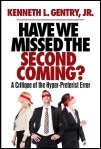
A Critique of the Hyper-preterist Error
by Ken Gentry
This book offers a brief introduction, summary, and critique of Hyper-preterism. Don’t let your church and Christian friends be blindfolded to this new error. To be forewarned is to be forearmed.
For more Christian educational materials: www.KennethGentry.com
“Another reason why we support the idea that the Rapture and the second coming are separate events is that the second coming is said to be visible to the whole earth (Revelation 1:7). However, in the Rapture, only the Christians see Him — it’s a mystery, a secret. When the living believers are taken out, the world is going to be mystified.”
Thus, one of the most influential dispensational authors uses the term, despite the anonymous writer declaring that “no-one” ever called it a secret rapture.
Major theologian Robert H. Gundry wrote The Church and the Tribulation, in which he classifies himself as a “dispensationalist” (p. 28). He is also called a dispensationalist in Thomas Ice and Tim Demy’s book, When the Trumpet Sounds: “Gundry, who is not only premillennial but also dispensational…” (p. 239). While discussing 1 Thess 4:16–17, Gundry refers to the secret rapture in his book: “The ‘shout,’ ‘voice,’ and ‘trumpet’ have led some posttribulationists to mock at a secret, pretribulational rapture…” (p. 104).
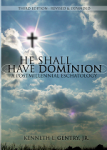
He Shall Have Dominion
(paperback by Kenneth Gentry)
A classic, thorough explanation and defense of postmillennialism (600+ pages). Complete with several chapters answering specific objections.
See more study materials at: www.KennethGentry.com
Dispensationalism requires that the Rapture be “secret”
We also find that the very theological construct of the Rapture entails that it be “secret.” According to the dictionary, the first meaning of “secret” is: “done, made, or conducted without the knowledge of others” (Dictionary.com). The second listed meaning there is: “kept from the knowledge of any but the initiated or privileged.” This is precisely how the Rapture must be characterized. Note the following.
Consider major dispensationalist theologian Charles L. Feinberg. In his book, Millennialism: The Two Major Views, p. 287 he distinguishes the Rapture from the Second Coming by noting: “The coming of the Lord Jesus for His own will not be seen by the world, whereas His visible appearing will be seen by all when He comes in power and great glory with His holy angles” (emph. mine). By definition, this Rapture coming is secret, for it “will not be seen by the world.” It is “done, made, or conducted without the knowledge of others” (“secret,” Dictionary.com).”
Another important dispensational theologian is Paul D. Feinberg. He is contributor to the debate book by Gleason Archer, et al., The Rapture: Pre–, Mid–, or Post–tribulation?). In that book he, too, distinguishes the Second Advent from the Rapture similarly: “The return of Christ is preceded by great upheaval, distress, and signs that alert one to its occurrence. Neither the trial nor the signs are to be found in the Rapture text…” (p. 157–58; emph. mine). Thus, it is “secret” as far as the world is concerned for it is “done, made, or conducted without the knowledge of others” (“secret,” Dictionary.com).”
Another extremely popular dispensationalist is Tim LaHaye’s. In his Prophecy Study Bible (at 1 Thess. 4:13) he provides a chart of “Comparisons between the Rapture and the Glorious Appearance.” In that chart, item five is: At the Rapture “Only His own see Him”; whereas in the “Glorious Appearance” (the Second Advent) “Every eye will see Him.” Thus, a major distinction between the Rapture and the Second Advent is that the Rapture is not seen by those who are not believers. Is this, then, not “secret”? Is this not “done, made, or conducted without the knowledge of others” (“secret,” Dictionary.com)?”
Norm Geisler in his Systematic Theology: Church, Last Things presents a similar chart to LaHaye, where he contrasts the “Rapture” and the “Second Coming” (p. 623): Under the “Rapture” column we read: “only believers see him.” Under the “Second Coming” column we read: “all people see him.”
John Walvoord, The Church in Prophecy, speaks of the Rapture as a secret event, though without using the express term:
“It is probable, however, that just as atmospheric clouds received the Lord when He ascended into heaven (Acts 1:9) and as He will come in the ‘clouds of heaven’ at His return to the earth, so here also at the rapture the church will be enveloped by the atmospheric heavens and thus be taken out of sight of men on earth. There is no indication, however, that residents of earth will be able to see church thus rapture.” If the residents of earth do not see it, is it not — by definition — “secret”? Is it not “done, made, or conducted without the knowledge of others” (“secret,” Dictionary.com)?
However, on p. 136 Walvoord expressly allows the concept:
“The revelation indicates that the event [the Rapture] will take place in a moment and apparently that the earth and its inhabitants are left undisturbed. The Scripture does not use the term ‘secret rapture,’ and there is no sure evidence what the world will see and hear at the time of rapture. On the other hand, the Scriptures do not give any indication that the rapture will be subject to observation by the world as a whole.” So then, he admits that “the Scripture does not use the term ‘secret,’” but he argues for its secrecy, nevertheless. After all, he declares “there is no sure evidence what the world will see and hear” and notes “on the other hand, the Scriptures do not give any indication that the rapture will be subject to observation by the world as a whole.” He has worked his way around the “problem” that the adjective “secret” is not applied to the rapture in Scripture, by declaring that it is, nonetheless, secret!

Perspectives on Pentecost (Richard Gaffin)
A careful examination of the New Testament teaching on the gifts of the Spirit. Makes a case for the cessation of tongues at the close of the apostolic era. Gaffin is professor emeritus of biblical and systematic theology at Westminster Theological Seminary, Philadelphia.
See more study materials at: www.KennethGentry.com
Then two paragraphs later Walvoord writes: “A survey of the major Scriptures dealing with the second coming reveal an entirely different picture than the rapture. In Matthew 24, it is indicated that the second coming of Christ will fill the heavens with glory and will be ‘as lightning cometh out of the east and shineth even unto the west…. In contrast to the rapture, the second coming will be a visible event which both saved and unsaved will see” (pp. 136–37; emph. mine).
Conclusion
Like it or not, dispensationalism requires a “secret” rapture. And dispensationalists can and do use the term. I created no straw man; nor did I deceive anyone. I do admit, however, to having not much emotion about the whole matter, unlike my adversary.
The Divorce of Israel: A Redemptive-Historical Interpretation of Revelation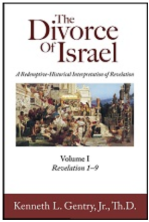
This long-awaited commentary is now at the printer and should be available for the public in late April, 2024. It is an 1800 page, two-volume deeply exegetical, academic commentary on the Bible’s most mysterious book.
Pre-order today for a special discount. Click: HERE
See more study materials at: www.KennethGentry.com
April 19, 2024
JESUS AND THE LAND
 PMW 2024-030 by Kenneth L. Gentry, Jr.
PMW 2024-030 by Kenneth L. Gentry, Jr.
The question of “the Land” is of paramount importance for the dispensationalist. Dispensationalism is a whole systematic theology — not simply an eschatology — that has as one of its chief cornerstones the predominant role of Israel in God’s plan for history. If the way to a man’s heart is through his stomach, the way to a dispensationalist’s heart is through the Land of Israel. Unfortunately, the whole New Testament contradicts it.
The Land question is also of enormous significance in the current wider world of politics and international relations. Many Christians consider themselves to be “Christian Zionists,” and strongly urge Western governments to support Israel — regardless.
In this blog I will provide a brief review of an excellent new book on the subject of the Israel and the Land: Jesus and the Land: The New Testament Challenge to “Holy Land” Theology (Baker Academic, 2010; 153 pp; soft cover). The author is Gary M. Burge, professor of New Testament at Wheaton College Graduate School.
THE APOCALYPSE OF JOHN
by Milton S. Terry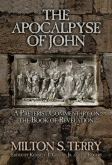
This book is Terry’s preterist commentary on the Book of Revelation. It was originally the last half of his much larger work, Biblical Apocalyptics. It is deeply-exegetical, tightly-argued, and clearly-presented.
For more study materials: https://www.kennethgentry.com/
Dr. Burge is a competent New Testament scholar, holding a Ph.D. from the University of Aberdeen. He is a member, The Society for Biblical Literature; Institute for Biblical Understanding; and Tyndale Fellowship for Biblical Research, Cambridge, England. He is also very knowledgeable regarding contemporary “Holy Land” issues. Besides this work he has authored Who Are God’s People in the Middle East? (1993) and Whose Land? Whose Promise? What Christians Are Not Being Told About Israel and the Palestinians (2003). He holds membership in Evangelicals for Middle East Understanding, as well as Holy Land Ecumenical Fellowship.
Though well qualified in the field, I confess that he does lack qualifications in three important areas: (1) He does not have a degree from Dallas Theological Seminary. (2) He is not a televangelist. (3) And as a consequence of #2 he does not appear to have bleached-white teeth. As a result of these three deficiencies he will not receive a wide reading among dispensationalists-in-the-pew.
The book is composed of eight succinct chapters and a helpful “Further reading” section. The chapters are: (1) The biblical heritage; (2) Diaspora Judaism and the land; (3) Jesus and the land; (4) The Fourth Gospel and the land; (5) The book of Acts and the land; (6) Paul and the promises to Abraham; (7) Developments beyond Paul; (8) Land, theology, and the Church.
Why does the book have the title “Jesus and the Land” since only one chapter deals directly with Jesus’s ministry? Judging from the chapter titles you would think it might be better titled “The New Testament and the Land.” However, the title perfectly captures the point of the book. As Burge compellingly argues: Jesus is the fulfillment of the old covenant and all of its promises, including the Land. Let us see how this unfolds.

Blessed Is He Who Reads: A Primer on the Book of Revelation
By Larry E. Ball
A basic survey of Revelation from an orthodox, evangelical, and Reformed preterist perspective. Ball understands John to be focusing on the destruction of Jerusalem and the temple in AD 70. Insightful. Easy to read.
For more Christian studies see: www.KennethGentry.com
After important introductory material in chapters 1 (Abraham and the Old Testament backdrop) and 2 (non-Judean, diaspora Judaism), we come to Burge’s central chapter: “Jesus and the land” (ch. 3). Here he carefully surveys relevant highlights from Jesus’ teaching in the Synoptic Gospels. He points out that despite the longing and perspective of many (not all!) first-century Jews, Jesus downplays the Land — as well as two other “holy places” for Israel: Jerusalem and the Temple. In a later chapter Burge captures this point well: “the lens of the incarnation had now refocused things completely. Christian theology had no room for ‘holy places’ outside of the Holy One who is Christ” (p. 94).
In his preaching the Lord begins transferring Israel’s hope from a Land to a Person; that is, to himself as the Messiah who has now come in fulfillment of the old covenant types, promises, and prophecies. Burge then traces and develops this theme in John, Acts, and Paul, with a briefer analysis of Hebrews and Revelation. He argues that as Israel rejects Christ: “The city at the center of Judaism’s religious aspirations has now failed some test that will lead to its judgment” (p. 45). As a consequence of Jesus’ teaching and Israel’s failure John develops his “theological agenda” which is “his messianic replacement (or fulfillment) motif” (p. 46).
In chapter 5 (“The book of Acts and the Land”) Burge shows Luke’s intentional theological structure, which traces Christian’s message and movement. He notes that both begin gradually to discount the Land: He reminds us that Jesus himself only ministered within Israel (Matt 10:5; 15:24). And though the Church begins in Jerusalem, it quickly starts moving away from Jerusalem and out of the Land. The largest discourse is Stephen’s sermon (which is the last speech given in Jerusalem): it represents diaspora Judaism outside of Israel rather than Judaism in the Land. Then Acts moves quickly to the Gentile world, ultimately focusing on and emphasizing Paul’s ministry in bringing in Gentiles.
In Acts, Luke does not appear simply to be tracing Christianity’s historical chronological growth. Rather Luke’s structure is more interested in presenting Christianity’s redemptive-historical theology. That is, Christianity is developing away from a Land-based theology to a Christ-based theology, away from a Jewish focus to a Gentile-focus.
As a result of all of this theological-structuring of Christianity’s development, Burge shows that “early Christian preaching is utterly uninterested in a Jews eschatology devoted to the restoration of the land” (p. 59; emph. his). And this is despite the fact that Paul usually begins his ministry in diaspora synagogues before reaching out to the Gentiles. Thus, Acts shows that “the Land of Promise was the source of Christianity’s legacy but no longer its goal” (p. 61). Thus, “the striking thing is that Paul here can refer to the promise of Abraham and not refer to the Land of Promise. . . . Paul is consistent with all the speeches in the book of Acts. Paul as well as Peter can consistently ignore the central elements in Abraham’s life according to Jewish teaching: land and progeny” (p. 68).
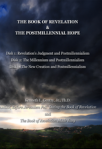 The Book of Revelation and Postmillennialism (Lectures by Ken Gentry)
The Book of Revelation and Postmillennialism (Lectures by Ken Gentry)
In the first of these three 50-minute lectures Gentry explains Revelation’s judgments to show they do not contradict postmillennialism. In the next two lectures he shows how the Millennium and the New Creation themes strongly support the gospel victory hope found in postmillennialism.
See more study materials at: www.KennethGentry.com
Though I wish he had developed the issue further, I was pleased to see that Burge at least holds to a semi-preterist understanding of Revelation, a view that is generally called the “idealist-preterist” approach. He even allows that Babylon “may also refer to Jerusalem, but also alludes to Rome itself” (p. 105). What is more, he states that “it may be that the harlot refers to Jerusalem or the high priest in his final corruption before the war” (p. 106) — which happens to be the view that I am developing in my commentary on Revelation. Thus, regarding the Land and the Book of Revelation, Burge properly notes: “In Revelation it is the Holy Land that becomes a land of violence toward the people of God and in the end is subject to judgment and devastation” (p. 108). This is right on target, and well put.
I highly recommend this book as a judicious and insightful study of the question of the Land of Israel in Scripture and theology. It deserves wide reading and discussion.
The Divorce of Israel: A Redemptive-Historical Interpretation of Revelation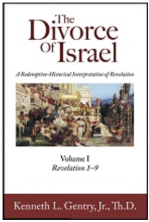
This long-awaited commentary is now at the printer and should be available for the public in late April, 2024. It is an 1800 page, two-volume deeply exegetical, academic commentary on the Bible’s most mysterious book.
Pre-order today for a special discount. Click: HERE
See more study materials at: www.KennethGentry.com
April 16, 2024
NOT ONE STONE?
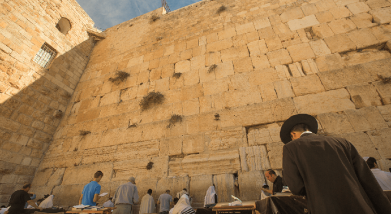 PMW 2024-029 by Kenneth L. Gentry, Jr., Th.D.
PMW 2024-029 by Kenneth L. Gentry, Jr., Th.D.
From time-to-time when I speak at conferences on the Olivet Discourse, I will have dispensationalists raise a question that they believe presents a problem for the preterist interpretation. I have even seen this in some published articles and books. Perhaps you have heard it yourselves. In fact, I know at least one of you have because you wrote me to ask me about it!
Now what is this challenge that some raise against the AD 70 fulfillment of the first portion of the Olivet Discourse? The challenge is:
How can you teach that AD 70 fulfills Jesus’ prophecy in Matthew 24:3? After all, that verse says “not one stone here shall be left upon another, which will not be torn down.” But we all know that the huge Wailing Wall that exists today was a part of the temple.
In reply I would note the following:
Foundation vs. Super-structure
First, the Wailing Wall is a portion of the retaining wall of the foundation of the temple, it is not a part of the temple building itself. The entire useable temple structure was demolished stone-by-stone. Josephus writes:
“Now as soon as the army had no more people to slay or to plunder, because there remained none to be the objects of their fury, (for they would not have spared any, had there remained any other work to be done,) Caesar gave orders that they should now demolish the entire city and temple, but should leave as many of the towers standing as were of the greatest eminency; that is, Phasaelus, and Hippicus, and Mariamne; and so much of the wall as enclosed the city on the west side. This wall was spared, in order to afford a camp for such as were to lie in garrison, as were the towers also spared, in order to demonstrate to posterity what kind of city it was, and how well fortified, which the Roman valor had subdued; but for all the rest of the wall, it was so thoroughly laid even with the ground by those that dug it up to the foundation, that there was left nothing to make those that came thither believe it had ever been inhabited. This was the end which Jerusalem came to by the madness of those that were for innovations; a city otherwise of great magnificence, and of mighty fame among all mankind” (J.W. 7:1:1).
Understanding the Olivet Discourse 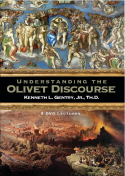
By Ken Gentry
This 5 DVD lecture set was filmed at a Bible Conference in Florida. It explains the entire Olivet Discourse in Matt. 24–25 from the (orthodox) preterist perspective. This lecture series begins by carefully analyzing Matt. 24:3, which establishes the two-part structure of the Discourse. It shows that the first section of the Discourse (Matt. 24:4–35) deals with the coming destruction of the temple and Jerusalem in AD 70. This important prophetic event is also theologically linked to the Final Judgment at the end of history, toward which AD 70 is a distant pointer.
For more educational materials: www. KennethGentry.com
Jesus prophesied while the temple stood and functioned. Before the Roman siege the temple was a magnificent structure that perfectly functioned as a temple for worship. In fact, Jesus’ prophecy is given just after he came out of the temple and was going away (Matt 24:1). After the siege the temple was a mass of rubble with only a few of its foundation stones remaining together. It was no longer magnificent; it was no longer suitable for worship. The “temple buildings” (Matt 24:1) were destroyed stone-by-stone.
Hyper-literalism
Second, to argue that this is a portion of the temple and that Matthew 24:2 has not yet been perfectly fulfilled and therefore still remains to be fulfilled is to demand a too literal interpretation. If we go that route, then we will have to dismiss numerous biblical prophecies that are not fulfilled in a pedantic manner and many biblical statements that are too generalistic.
For instance, in Acts 21:10–11 Luke writes: “And as we were staying there for some days, a certain prophet named Agabus came down from Judea. And coming to us, he took Paul’s belt and bound his own feet and hands, and said, ‘This is what the Holy Spirit says: “In this way the Jews at Jerusalem will bind the man who owns this belt and deliver him into the hands of the Gentiles.”’” Yet this prophecy did not come to pass in the exact manner presented.
We find this prophecy’s fulfillment in Acts 21:31, 33. But there it is not the Jews who physically bind him and deliver him to the Romans, but the Romans who seize him from the hands of the Jews who were attempting to kill him: “And while they were seeking to kill him, report came up to the commander of the Roman cohort that all Jerusalem was in confusion…. Then the commander came up and took hold of him, and ordered him to be bound with two chains.” Thus, it was not the Jews who literally “bind” Paul and then physically “deliver” Paul into the hands of the Gentiles. In fact, they were trying to kill him (Acts 21:31). He was rescued from the Jews, not delivered by them (Acts 21:32–25). Yet the fundamental, important point of Agabus prophecy is established: Paul went to Jerusalem and because of the Jews he ended up in jail by the Romans.
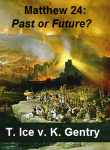
Matthew 24 Debate: Past or Future?
(DVD by Ken Gentry and Thomas Ice)
Two hour public debate between Ken Gentry and Thomas Ice on the Olivet Discourse.
See more study materials at: www.KennethGentry.com
Another example appears in Malachi 4:5: “Behold, I am going to send you Elijah the prophet before the coming of the great and terrible day of the Lord.” Despite this rather clear prophecy of “Elijah’s” return, Jesus clearly and dogmatically informs us of the non-Elijah fulfillment of the prophecy: “I say to you, that Elijah already came, and they did not recognize him…. Then the disciples understood that He had spoken to them about John the Baptist” (Matt. 17:11, 12). Yet the prophecy was fulfilled by someone coming in the spirit and power of Elijah.
Again were this pedantic hermeneutic employed, Peter could be faulted for an erroneous historical statement in Acts 1:18. There he stated that Judas purchased a field with the silver he received for betraying Christ. But Matthew 27:1–7 shows us that Judas was dead when the field was purchased by others. Yet the fundamental, relevant idea remains: the field was purchased with Judas’ payment for betraying Jesus.
Also what would we do with the several references that say the Jews crucified Christ? This is very much parallel to the situation presently before us. For instance, in Acts 3:13–14 we read:
“You disowned the Holy and Righteous One, and asked for a murderer to be granted to you, but put to death the Prince of life, the one whom God raised from the dead, a fact to which we are witnesses.” In Acts 5:30 Peter declares: “The God of our fathers raised up Jesus, whom you had put to death by hanging Him on a cross.”
These verses declare that the Jews “put to death” Jesus, even by “hanging Him on a cross.” Yet we know as a matter of historical record that the Romans were the ones who actually crucified Christ. John 19:13-16 is clear that Pilate “delivered Him up” to be crucified, for the Jews were not allowed the right to capital punishment (John 18:29–32). But the fundamental truth remains: the Jews cause Christ’s crucifixion.
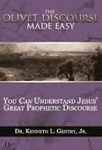
Olivet Discourse Made Easy (by Ken Gentry)
Verse-by-verse analysis of Christ’s teaching on Jerusalem’s destruction in Matt 24. Shows the great tribulation is past, having occurred in AD 70, and is distinct from the Second Advent at the end of history.
See more study materials at: www.KennethGentry.com
Christ as False Prophet
Third, to argue that this is some portion of the temple and that Matthew 24:2 has not yet been perfectly fulfilled and therefore still awaits fulfillment causes Christ himself to be a false prophet.
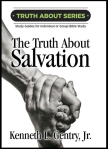 The Truth about Salvation By Ken Gentry
The Truth about Salvation By Ken Gentry
A study guide for personal or small group Bible study. Deals with the Christian doctrine of salvation from a Reformed theological perspective. It opens with a study of God as loving Creator, the shows how the first man fell into sin. Shows God’s righteousness requires that sin be dealt with. Presents Jesus as both God and man so that he can be man’s Savior. Includes review questions and questions for further study.Twelve chapters are ideal for one quarter of Sunday School.
See more study materials at: www.KennethGentry.com
After all, the text states that the disciples pointed out the temple buildings to him, the very buildings from which he had just come (Matt 24:1). Then he says “to them” (those disciples who had just pointed to those temple buildings): “Do you not see all these things? Truly I say to you, not one stone here shall be left upon another, which will not be torn down” (Matt 24:2). They asked him “when will these things be” (Matt 24:3)? He informs them that a number of things must occur first (Matt 24:6, 8), but that finally: “this generation will not pass away until all these things take place” (Matt 24:34). Was Christ mistaken?
Get Your Facts Straight
Fourth, in the final analysis, if some hapless dispensationalism stumbles into your conversation on the Olivet Discourse and mutters this complaint (that some stones of the temple still remain, therefore the prophecy has not been fulfilled), direct him to go to any number of dispensationalist works that state that Matthew 24:2 was fulfilled in AD 70.
For instance, in Tim LaHaye’s Popular Encyclopedia of Bible Prophecy we read: “Clearly the [disciples] first question related to the destruction of the Temple, which happened during the Roman invasion and destruction of Jerusalem in A.D. 70” and “the disciples’ first question in the Olivet Discourse relates to the destruction of Jerusalem in A.D. 70” (p. 249). The Tim LaHaye Prophecy Study Bible states the same thing (p. 1151).
Then, if he will still not listen to you: Go to his house and take it apart stone-by-stone. If he complains you can respond: “But there are a couple of stones still connected, so nothing of the sort of thing you complain about really happened.”
The Divorce of Israel: A Redemptive-Historical Interpretation of Revelation
This long-awaited commentary is now at the printer and should be available for the public in late April, 2024. It is an 1800 page, two-volume deeply exegetical, academic commentary on the Bible’s most mysterious book.
Pre-order today for a special discount. Click: HERE
April 12, 2024
LITERALISM AND MESSIAH’S REJECTION
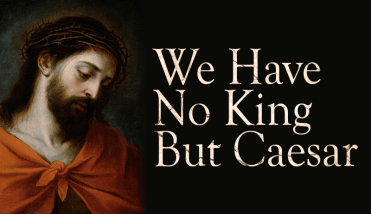 PMW 2024-028 by Kenneth L. Gentry, Jr.
PMW 2024-028 by Kenneth L. Gentry, Jr.
The two cornerstones of dispensationalism are: (1) Israel and the Church must be kept distinct as two separate peoples of God throughout all eternity. (2) Scripture must be interpreted literalistically unless it would lead to absurdity. Both of these foundational premises are absolutely erroneous. In this blog I will briefly demonstrate the tragedy of literalism for both first century Israel and present-day dispensationalism.
The Error of Dispensational Literalism
Dispensationalists proudly point out that first century Jewish rabbis interpreted the Old Testament literalistically. In fact, this claim is often made at the beginning of their argument for literalism in an effort to establish the historical nature of their hermeneutic. For instance, Dallas Seminary’s J. Dwight Pentecost asserts: “The prevailing method of interpretation among the Jews at the time of Christ was certainly the literal method of interpretation” (Things to Come, 17). Popular and prolific dispensational author Malcolm Ollie Couch, Jr. agrees: “Jewish orthodoxy generally interpreted the Old Testament literally” (Popular Encyclopedia of Bible Prophecy, 148).
Unfortunately, literalism was not only a tragedy for the Jews, but is an embarrassment to their best friends, the dispensationalists. (And through dispensationalism’s behemoth presence in American Christian circles, an embarrassment to evangelical theology.) Let us see how this is so.
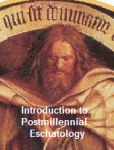
Introduction to Postmillennial Eschatology (10 downloadable mp3 lectures)
by Ken Gentry
Lecture presentations and some classroom interaction. Very helpful definition, presentation, and defense of postmillennialism.
See more study materials at: www.KennethGentry.com
The Tragedy of Jewish Literalism
The tragedy of literalism for Israel was perhaps the key human component leading the nation to reject their own prophesied Messiah. Evangelical theologian Stanley J. Grenz observes “it was their expectations of a literal earthly kingdom and political ruler that caused many Jews to fail to recognize Jesus as their Messiah at his first coming” (The Millennial Maze, 79). Interestingly, we see this point made throughout John’s Gospel. Indeed, it seems almost as if his Gospel was designed to demonstrate this affliction
John’s Gospel opens early-on with a foreboding lament: “He came to His own, and those who were His own did not receive Him” (John 1:11). And this was despite the fact that Jesus was “the light of men. And the light shines in the darkness; and the darkness did not comprehend it” (John 1:4b–5). Then throughout his Gospel John repeatedly points out why this happened: it was due to the naive literalism of the majority of first-century Jews.
Jesus even has to rebuke a religious leader in Israel for this nonsense. In John 2 Jesus is at the Temple during Passover where he drives the moneychangers out of the Temple court. The temple authorities confront him, asking: “What sign do You show to us, seeing that You do these things” (John 2:18). John records Jesus’ response and the Jewish confusion based on their literalistic interpretation of it: “Jesus answered and said to them, ‘Destroy this temple, and in three days I will raise it up.’ The Jews therefore said, ‘It took forty-six years to build this temple, and will You raise it up in three days?’” (John 2:19–20). John exposes their error by properly interpreting Jesus’ answer: “But He was speaking of the temple of His body” (John 2:21).
House Divided: The Break-up of Dispensational Theology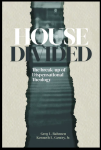 By Greg Bahnsen and Ken Gentry
By Greg Bahnsen and Ken Gentry
This book presents and defends Christian Reconstruction theology, particularly theonomic ethics and postmillennial eschatology. It does to by responding to dispensationalism’s social and exegetical theology.
For more educational materials: www. KennethGentry.com
Just five verses later John records Jesus’ interaction with “a man of the Pharisees, named Nicodemus, a ruler of the Jews” (John 3:1). Nicodemus informs Jesus that he recognizes the significance of Jesus’ miracles. Then we read: “Jesus answered and said to him, ‘Truly, truly, I say to you, unless one is born again, he cannot see the kingdom of God.’ Nicodemus said to Him, ‘How can a man be born when he is old? He cannot enter a second time into his mother’s womb and be born, can he?’ (John 3:3–4). He totally misses Jesus’ teaching on being “born again.” Here is a ruler of the Jews thinking as a dispensationalist: apparently for him “truly, truly” meant “literally, literally.”
But how does Jesus respond? With a sharp rebuke and a correction to his literalism. “Jesus answered, ‘Truly, truly, I say to you, unless one is born of water and the Spirit, he cannot enter into the kingdom of God. That which is born of the flesh is flesh, and that which is born of the Spirit is spirit. Do not marvel that I said to you, “You must be born again. . . .’” ‘Are you the teacher of Israel, and do not understand these things?’ . . . If I told you earthly things and you do not believe, how shall you believe if I tell you heavenly things?” (John 3:5–7, 10, 12). Ouch! Here is an educated Pharisee, a “ruler of the Jews” being questioned as to his intelligence because of his literalistic approach.
Then in the next chapter we find another encounter of Jesus. This time with the Samaritan woman at the well. In his interaction with her we discover her dullness of understanding which is also rooted in simplistic literalism.
“Jesus answered and said to her, ‘If you knew the gift of God, and who it is who says to you, “Give Me a drink,” you would have asked Him, and He would have given you living water.’ She said to Him, ‘Sir, You have nothing to draw with and the well is deep; where then do You get that living water? You are not greater than our father Jacob, are You, who gave us the well, and drank of it himself, and his sons, and his cattle?’ Jesus answered and said to her, ‘Everyone who drinks of this water shall thirst again; but whoever drinks of the water that I shall give him shall never thirst; but the water that I shall give him shall become in him a well of water springing up to eternal life. The woman said to Him, ‘Sir, give me this water, so I will not be thirsty, nor come all the way here to draw’” (John 4:10–15).
If Jesus teaches about his providing “living water” had prompted his hearers to go about looking for ladles, they would be sorely disappointed. She missed his spiritual instruction because of her literalistic assumption.
But this is not all, for we read further: “In the meanwhile the disciples were requesting Him, saying, ‘Rabbi, eat.’ But He said to them, ‘I have food to eat that you do not know about.’ The disciples therefore were saying to one another, ‘No one brought Him anything to eat, did he?’ Jesus said to them, ‘My food is to do the will of Him who sent Me, and to accomplish His work. Do you not say, “There are yet four months, and then comes the harvest”? Behold, I say to you, lift up your eyes, and look on the fields, that they are white for harvest. Already he who reaps is receiving wages, and is gathering fruit for life eternal; that he who sows and he who reaps may rejoice together. For in this case the saying is true, “One sows, and another reaps.” I sent you to reap that for which you have not labored; others have labored, and you have entered into their labor’” (John 4:31–38).
 Dispensational Distortions (3 downloadable mp3s)
Dispensational Distortions (3 downloadable mp3s)
by Ken Gentry
Reformed introduction to classic dispensationalism, with analysis of leading flaws regarding the Church, kingdom, redemptive history, and Christ. Helpful for demonstrating errors to dispensationalists.
See more study materials at: www.KennethGentry.com
Had Jesus not constrained them they would have probably run off to begin looking for a sickle to help him harvest some wheat while the Samaritan woman went off looking for a longer ladle. No wonder people back then were such hard workers. They took everything so literally. (By saying they “took” everything literally, I do not mean they manually lifted everything up and hauled it off to another geographical destination. You can’t have everything: where would you put it?).
Later Jesus really gets into trouble and offended a crowd of literalistic Jews. He does so after miraculously feeding 5000 of them (John 6:1–14, 24–26). We see literalism raising its dense head once again when the Jews finally find him shortly thereafter:
“‘Our fathers ate the manna in the wilderness; as it is written, “He gave them bread out of heaven to eat.”’ Jesus therefore said to them, ‘Truly, truly, I say to you, it is not Moses who has given you the bread out of heaven, but it is My Father who gives you the true bread out of heaven. For the bread of God is that which comes down out of heaven, and gives life to the world.’ They said therefore to Him, ‘Lord, evermore give us this bread.’ Jesus said to them, ‘I am the bread of life; he who comes to Me shall not hunger, and he who believes in Me shall never thirst.’ (John 6:31– 35). The story continues:
“‘I am the living bread that came down out of heaven; if anyone eats of this bread, he shall live forever; and the bread also which I shall give for the life of the world is My flesh.’ The Jews therefore began to argue with one another, saying, ‘How can this man give us His flesh to eat?’ Jesus therefore said to them, ‘Truly, truly, I say to you, unless you eat the flesh of the Son of Man and drink His blood, you have no life in yourselves. He who eats My flesh and drinks My blood has eternal life, and I will raise him up on the last day. For My flesh is true food, and My blood is true drink. He who eats My flesh and drinks My blood abides in Me, and I in him. As the living Father sent Me, and I live because of the Father, so he who eats Me, he also shall live because of Me. This is the bread which came down out of heaven; not as the fathers ate, and died, he who eats this bread shall live forever’” (John 6:51– 58).
And you know what happens next (John has already established the pattern for you!): “Many therefore of His disciples, when they heard this said, ‘This is a difficult statement; who can listen to it?’ But Jesus, conscious that His disciples grumbled at this, said to them, ‘Does this cause you to stumble?’ . . . As a result of this many of His disciples withdrew, and were not walking with Him anymore” (John 6:60–61, 66).
All of this interpretive stumbling does not end here! It continues on relentlessly throughout John’s record. In John 8:21–22 we read: “He said therefore again to them, ‘I go away, and you shall seek Me, and shall die in your sin; where I am going, you cannot come. Therefore the Jews were saying, ‘Surely He will not kill Himself, will He, since He says, “Where I am going, you cannot come”?’” (John 8:21–22).
Then a few verses later we read of Jesus’ preaching: “‘You shall know the truth, and the truth shall make you free.’ They answered Him, ‘We are Abraham’s offspring, and have never yet been enslaved to anyone; how is it that You say, “You shall become free”?’ Jesus answered them, ‘Truly, truly, I say to you, everyone who commits sin is the slave of sin. And the slave does not remain in the house forever; the son does remain forever. If therefore the Son shall make you free, you shall be free indeed” (John 8:32–36). They were in danger of remaining in slavery to sin because they could not understand Jesus’ warning about that spiritual slavery, partly due to their literalism.
 Christian Theistic Ethics (29 mp3 downloads)
Christian Theistic Ethics (29 mp3 downloads)
by Ken Gentry
Formal Christ College course on Christian Theistic Ethics. Explains and defends theonomic ethics from the Scriptures of both the Old and New Testaments. Helpful for introducing theonomy to Christians living in our secular times and desiring to understand biblical ethics.
See more study materials at: www.KennethGentry.com
Then just a few more verses afterwards we see the same problem arising again: “‘Truly, truly, I say to you, if anyone keeps My word he shall never see death.’ The Jews said to Him, ‘Now we know that You have a demon. Abraham died, and the prophets also; and You say, “If anyone keeps My word, he shall never taste of death.” Surely You are not greater than our father Abraham, who died? The prophets died too; whom do You make Yourself out to be?’” (John 8:51–53).
Just a few verse later in the following context (beginning in John 9:1) Jesus heals a blind man. Then he causes confusion by speaking of spiritual blindness to the dispensationalist Pharisees. (We know they were dispensationalists because they not only were literalists but they also held to the distinction between the Church and Israel — as well as believing in a special future for Israel wherein they would rule the world.) “And Jesus said, ‘For judgment I came into this world, that those who do not see may see; and that those who see may become blind.’ Those of the Pharisees who were with Him heard these things, and said to Him, ‘We are not blind too, are we?’” (John 9:39–40). They had confronted him regarding his healing of the blind man. So when Jesus calls them “blind,” they literalistically assume he is speaking of physical blindness.
Jesus’ own closest associates were Jewish, and therefore afflicted with literalism. We see this in the episode of the raising of Lazarus: “This He said, and after that He said to them, ‘Our friend Lazarus has fallen asleep; but I go, that I may awaken him out of sleep.’ The disciples therefore said to Him, ‘Lord, if he has fallen asleep, he will recover.’” But once again, John helps us out by adding: “Now Jesus had spoken of his death, but they thought that He was speaking of literal sleep. Then Jesus therefore said to them plainly, ‘Lazarus is dead’” (John 11:11–14).
Even Peter, the leading disciple and one of the inner circle of three (with James and John, cf. Mark 5:37; 9:2; 13:3; 14:33), was confused by his cultural literalism: Jesus said: “‘Little children, I am with you a little while longer. You shall seek Me; and as I said to the Jews, I now say to you also, “Where I am going, you cannot come.”’ . . . Simon Peter said to Him, ‘Lord, where are You going?’ Jesus answered, ‘Where I go, you cannot follow Me now; but you shall follow later.’ Peter said to Him, ‘Lord, why can I not follow You right now?’” (John 13:33, 36–37).
Literalism is such a bad problem among the Jews that Jesus has to interact with Pilate to discover whether Pilate had directly heard him speak on the kingdom of heaven, or whether he got all of his information from the Jews. As we can tell from the preceding narrative in John’s Gospel, this was a great concern for Jesus since the Jews tended to misconstrue his teaching by subjecting it to a literalistic analysis. Thus we read:
“Pilate therefore entered again into the Praetorium, and summoned Jesus, and said to Him, ‘Are You the King of the Jews?’ Jesus answered, ‘Are you saying this on your own initiative, or did others tell you about Me?’ Pilate answered, ‘I am not a Jew, am I? Your own nation and the chief priests delivered You up to me; what have You done?’ Jesus answered, ‘My kingdom is not of this world. If My kingdom were of this world, then My servants would be fighting, that I might not be delivered up to the Jews; but as it is, My kingdom is not of this realm.’ Pilate therefore said to Him, ‘So You are a king?’ Jesus answered, ‘You say correctly that I am a king. For this I have been born, and for this I have come into the world, to bear witness to the truth. Everyone who is of the truth hears My voice’” (John 18:33-37).
Thus, once Jesus discounts any Jewish, literalistic interpretation of his kingdom sayings. He informs Pilate he is indeed a “king.” But he defines his kingdom as a spiritual kingdom not of this world, a kingdom related to the proclamation of truth and uninterested in armies and a police force. His kingdom is spiritual, not literal . And because of his answer we read: “Pilate said to Him, ‘What is truth?’ And when he had said this, he went out again to the Jews, and said to them, ‘I find no guilt in Him’” (John 18:38). He well knew, as did the Jews, that “everyone who makes himself out to be a king opposes Caesar” (John 19:12). Yet as Caesar’s appointed procurator Pilate stated: “I find no guilt in Him.”
Ecclesiology Course
25 Gentry downloadable class lectures
Full Christ College course lectures on the doctrine of the Church.
Includes sizeable study of the sacraments.
See more study materials at: www.KennethGentry.com
Conclusion
In all of this we see the dangers of a naive literalism. It caused Jesus’ embarrassing rebuke of a high-ranking Jewish leader (Nicodemus). It caused many would-be disciples to turn away from him. It caused his disciples to be confused. It caused the Jews to reject Jesus as Messiah. It even caused them to demand his crucifixion (cp. Matt 27:29, 37)
Furthermore, the literalistic hermeneutic eventually created a whole, new theological movement in history 1800 years after Christ: dispensationalism was founded in 1830. This movement has created its own rapturistic theological system. It has also caused embarrassment to the broader evangelical faith by its naive theology, with all of its calls for the end, demands for preferential treatment for Jews, and for almost the entire herd of televangelists.
The Divorce of Israel: A Redemptive-Historical Interpretation of Revelation
This long-awaited commentary is now at the printer and should be available for the public in late April, 2024. It is an 1800 page, two-volume deeply exegetical, academic commentary on the Bible’s most mysterious book.
Pre-order today for a special discount. Click: HERE
April 9, 2024
HOPE IN THE FUTURE
 PMW 2024-027 by Kenneth L. Gentry, Jr., Th.D..
PMW 2024-027 by Kenneth L. Gentry, Jr., Th.D..
In his letter to the troubled Corinthian church, Paul lists three Christians virtues while exhorting them to a closer walk with Christ: faith, hope, and love (1 Cor. 13:13). This three-fold cord of holy values provides a strong bond of commitment for the Christian, and has tied the Church of Jesus Christ together throughout the ages.
Faith and love are not only beautiful threads knitting together the fabric of the Christian life, but are easily recognized as such. They weave a strong carpet for the Christian walk; they serve as dual strands tugging us forward in our holy calling. And though hope is certainly not a detached thread from the Christian garment, it has been snagged loose and at best is only partially visible to the eye of faith today.
Certainly all Christians are united in recognizing our ultimate, glorious resurrection hope in our heavenly home. We know that the present fallen order is not all that we may expect in our experience of God’s grace. The beatific vision in Scripture encourages us to keep a hopeful eye on heaven above even as we watch our steps in the earth below. And though eternal life in the presence of God is the ultimate hope of the Christian and the abiding consequence of the gospel, it does not exhaust the full significance of biblical hope.
Earthly Hope Encouraged
The Scripture urges us not only to look to our eternal estate in heaven, but also to labor in hope in the temporal realm on earth, knowing that “the earth is the Lord’s, and all its fullness, the world and those who dwell therein” (Psa. 24:1). We must remember that this present material order was created by God’s power and for His glory: “You are worthy, O Lord, to receive glory and honor and power; for You created all things, and by Your will they exist and were created” (Rev. 4:11). Consequently, a robust Christian faith must also share in a prophetic hope for our earthly future. Unfortunately though, many evangelicals cannot penetrate the cloud of gloom cloaking our present earthly labors; with troublesome nearsightedness we see only the short-term decline of Christianity rather than its long-range revival.
Three Views on the Millennium and Beyond
(ed. by Darrell Bock)
Presents three views on the millennium: progressive dispensationalist, amillennialist, and reconstructionist postmillennialist viewpoints. Includes separate responses to each view. Ken Gentry provides the postmillennial contribution.
See more study materials at: www.KennethGentry.com
One reason historical hope is so obscured for us is that, as with the news media, so is it with the modern Christian: We tend to focus on the bad news and overlook the good. Of course, we would certainly be naively foolish if we closed our eyes to the many glaring problems in this rebellious world. But to help us overcome this myopia we must exercise the eye of faith. We should look back at the glowing embers of temporal hope that have flared up in history from time to time. These “thousand points of light” gloriously demonstrate the unquenchable fire of an ever burning Christian hope. These historical specimens provide confirmation of the certainty of the prophetic hope of Scripture. They should encourage us in our faith, love, and hope.
Earthly Hope in Scripture
Consider the Old Testament struggle of faith. Childless, aged Abram was called by God to leave his homeland, and “by faith Abraham obeyed when he was called to go . . . and he went out, not knowing where he was going” (Heb. 11:8). Why? Why would a weary old man leave home and country? Because of bright prospect of hope in the future! The ellipsis in the preceding citation from Hebrews notes that he was called “out to the place which he would receive as an inheritance.” An earthly inheritance lay before him, for God Himself promised him: “Go . . . to the land which I will show you; and I will make you a great nation; I will bless you and make your name great; and you shall be a blessing” (Gen. 12:1-2). Abram departed his father’s house for a strange land because of a God-revealed hope of a more fruitful earthly future. Due to Abram’s confidence in God’s earthly promise, his name was change to “Abraham” — “father of multitudes” (Gen. 17:5).
And should we today not follow Abraham’s example, trusting in God’s promise regarding our earthly hope? The Abrahamic Covenant not only brought forth a populous nation of God’s people, but promised that in Abram “all the families of the earth shall be blessed” (Gen. 12:3c). That is, biblical hope promised that from an elderly, barren man would descend not only a great nation in history, but ultimately the Messiah who would bring blessings “to all the families of the earth.”
This glorious One from Abraham’s loins conquered sin (Rom. 7:24-25), death (1 Cor. 15:54-55), and the devil (Col. 2:15) through his redemptive labors. And on that basis redemptively secured the Abrahamic hope of blessing in time and on earth. For Christ commanded his disciples themselves to go out into an alien and resistant world in order to “make disciples of all the nations, baptizing them in the name of the Father and of the Son and of the Holy Spirit” (Matt. 28:19). “All the nations” and “all the families of the earth” are to be brought under the sway of God’s covenant love and Christ’s redemptive kingdom.
Thine Is the Kingdom
(ed. by Ken Gentry)
Contributors lay the scriptural foundation for a biblically-based, hope-filled postmillennial eschatology, while showing what it means to be postmillennial in the real world.
See more study materials at: www.KennethGentry.com
Earthly Hope in History
The early ante-Nicene church struggled mightily in their task. Initially, they were but a “little flock” (Luke 12:32) who humbly committed their lives to a despised, rejected, and crucified Lord (1 Cor. 2:8). Initially, they were hunted down by the mightiest empire of the world, to be thrown to the beasts for refusing to worship Caesar, to be burned in the fires for affirming Christ’s lordship. Surely their times were fraught with unspeakable terror such as we have not known in modern America. Yet by the grace of God, a little over 200 years after the Apostles left the scene the emperor Constantine professed faith in Christ, lifting the earthly burden from our spiritual forefathers. Christ’s little flock was witnessing His kingdom coming with power, His gospel exercising a growing influence in the world.
Indeed, shortly thereafter Athanasius wrote: “the Saviour works so great things among men, and day by day is invisibly persuading so great a multitude from every side, both from them that dwell in Greece and in foreign lands, to come over to His faith, and all to obey His teaching” (Incarnation 30:4). In ever greater numbers idol worshipers were turning from their lifeless idols to serve the living God (cp. 2 Thess. 1:9). The mustard seed was growing in stature; the leaven was powerfully penetrating the earth (Matt. 13:31-33).
Consider the plight of faithful Christians who were later tormented by a corrupted form of Christianity in the Middle Ages. They were burned at the stake for their evangelical faith in Christ. And though the Church of the day was in such a tragic condition, the Reformation erupted on the scene shaking the very foundations of western civilization. Christians were witnessing the answer to their continuing hope-filled petition to God: “Thy kingdom come; they will be done on earth as it is in heaven.” Once again Christian hope burned anew in time and on earth. The flame of Christ was inextinguishable.
Consider the plight of the bold believers in England as the Reformation flared up there, then died back, only to flame forth again. Faithful ministers were hounded from their pulpits and humble saints beheaded for their faith, taunted as “Puritans.” Yet, as before, the evangelical faith shook itself and arose, bringing forth the Puritan hope and the explosion of a massive Christian missionary outreach. In their earnest hope of serving God without constraints, they migrated to the New Land to establish “a city set on a hill.”
The Truth about Postmillennialism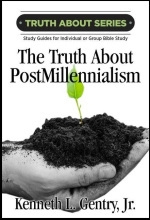 By Ken Gentry
By Ken Gentry
A group Bible study guide for explaining the optimistic prophetic hope for this world to be accomplished before Christ’s Second Coming. Establishes the postmillennial system in both the Old and New Testaments. Touches on key eschatological issues, such as creation, covenant, interpretive methodolgy, the great tribulation, the Book of Revelation, the Jewish Temple, and more. It presents and answers the leading objections to postmillennialism.Twelve chapters are ideal for one quarter of Sunday School.
See more study materials at: www.KennethGentry.com
Earthly Hope in the Present
Of course, once again we today look around with growing despair and a deepening concern for our country. Our Christian influence is waning in America. We hear tragic reports of various evils in our land and in the world. What are we to think? Shall our hope fade with the troubling news? May it never be! As did lonely Abram of old, so must we advance in hope of God’s will being effected in the earth which belongs to Him. We should be encouraged by the continuing historical resilience of our faith. What a “great cloud of witnesses” has preceded us!
We must remember the bold hope of Jeremiah. Though he prophesied the fast approaching destruction of Jerusalem, even penning a book of prophecy so disturbing we call it “Lamentations,” yet did he still hope. He looked beyond the dismal events of his day, his eyes penetrating the dark clouds of despair. He was so confident that the earthly future was in God’s hands that he purchased a piece of land in doomed Israel (Jer. 32). He believed that history was indeed “His story,” and not man’s.
We must have a hope such as did righteous Simeon. His beloved nation was subjugated to Imperial Rome. His longed-for Messiah had not come despite hundreds of years of prophetic hope. Yet like Abram and Jeremiah before him, he too continued with hope. He confidently awaited the Messiah in the Temple of God: “And behold, there was a man in Jerusalem whose name was Simeon; and this man was righteous and devout, looking for the consolation of Israel; and the Holy Spirit was upon him” (Luke 2:25). And what became of his hope? He saw in the baby Jesus “Thy salvation, which Thou hast prepared in the presence of all peoples, a light of revelation to the Gentiles, and the glory of Thy people Israel’” (Luke 2:30b-32).
Ultimately, of course, we must draw our hope for the earthly future not from “below the sun,” feeding it solely from an historical tributary. After all, we do not yet see the end result; we can trace only the slow, developing providence of God through the shifting sands of time. Yet we know that He has promised that His kingdom will grow imperceptibly in the earth, like a budding twig (Eze. 17:22-24), a growing stream (Eze. 47:1-12), a developing mustard seed (Matt. 13:31-32), penetrating leaven (Matt. 13:33), a sprouting seed (Mark 4:26-29). Nowhere does the Scripture promise that by the year 2002 will we see the full fruit of a conquering faith and the mature and final blossoming of earthly hope. We must draw our hope from above the sun, from the light of God’s revelation in the prophetic Scriptures. But we can discern the ways of God from his actions in the past in delivering His people and granting them victory despite opposition.
We should no more be discouraged in our hope of the conquest of our faith in the earth because it has not yet transpired in fulness, than we should despair regarding the Lord’s return simply because He has not yet done so. We must have a hope in the future.
The Divorce of Israel: A Redemptive-Historical Interpretation of Revelation
This long-awaited commentary is now at the printer and should be available for the public in late April, 2024. It is an 1800 page, two-volume deeply exegetical, academic commentary on the Bible’s most mysterious book.
Pre-order today for a special discount. Click: HERE
April 5, 2024
TOLERANCE, AND SOCIAL MORALITY
 PMW 2024-026 by Kenneth L. Gentry, Jr., Th. D.
PMW 2024-026 by Kenneth L. Gentry, Jr., Th. D.
I live in the deep south, and right in the middle of the Bible belt. Unfortunately, we have gotten a taste of the homosexual revolution in our area. Awhile back recent news items, editorials, and letters to the editor debated the question of homosexuality. Tragically, the conservative South and Christian dominated cities are not immune to the moral decline and degradation of our culture.
Unfortunately, the whole controversy is a study in muddled ethical thinking, contradictory assertions, sloganeering, and outlandish charges. The local resistance to homosexual culture has been ridiculed as: “a breach of the separation of church and state,” “Naziism,” “menacing authority,” “an atrocity,” “right-wing extremism,” “poisonous,” “ayatollah-like,” “warped,” “a return to the dark ages,” “frightening,” “appalling,” “a witch hunt,” and more. Consequently, the dispute exposes our inability to think through moral issues. But public socio-political discourse is not the place for such moral confusion.
So for these reasons, even if for no other, the methodology of the moral charges levied against the Christian concerns demand careful analysis. I will focus on the two highly charged issues so prominent in the debate both locally and nationally: privacy and tolerance.
 Homosexuality, Transgenderism, and Society
Homosexuality, Transgenderism, and Society
5 downloadable mp3s by Ken Gentry
The homosexual movement is one of the leading challenges to the moral stability of American culture and to our Christian influence in culture. In this sermon series the homosexual question is tackled head on.
See more study materials at: www.KennethGentry.com
The Right to Privacy
First, the privacy issue: Those who fear this matter coming under legal scrutiny as an “invasion of privacy” by “senseless government intrusion” seem unaware of current legal realities. Government is already (and necessarily) involved in private moral concerns. The liberty ideal asserting the primacy and inviolability of privacy rights has never been the case in America. We have many laws restricting the private acts of consenting adults, including laws against polygamy, prostitution, incest, illegal drug use, bestiality, consensual sado-masochism, suicide, and more.
We also have anti-privacy laws demanding compulsory education, overriding private family convictions regarding medical treatment (e.g., forced blood transfusions for ill children), forbidding cruelty to animals, and so forth. Privacy is only one value among many other competing values. At points of collision, privacy values must give place to other values such as justice, security, and human life.
Private morality cannot be a matter of public indifference. If civil law failed to witness against the abnormality of homosexual conduct, then governmental authority would be encouragin a progressive degeneration of moral values in society. This would be detrimental to society’s moral stability, government’s legal substructure, the dignity of human life, the monogamous foundation of all civilized societies, the ability of parents to raise their children in a stable moral environment, and more. The issues relative to privacy are of gigantic proportions and poorly understood.
 Contemporary Theological Issues
Contemporary Theological Issues
by Ken Gentry (21 mp3 downloadables)
A Christian college course dealing with contemporary theological debates within the church. Covers several important topics of concern to Christians, including abortion, homosexuality, alcoholic beverages, and more
See more study materials at: www.KennethGentry.com
The Toleration of Diversity
Second, the toleration issue: The call for “tolerance” is a moral demand. That being the case, it must come from within a particular moral system. And the system that best supports and gives meaning to public, universal, invariant moral principles must be recognized and defensible. This, then, requires public moral discourse which cannot preclude the Christian system at the outset, as so many try to do.
In fact, on historical grounds this “one nation under God” that asserts “In God we trust” should not disallow Christian moral values. The U. S. Supreme Court has noted in Zorach v. Clauson that “we are a religious people whose institutions presuppose a Supreme Being” (343 U.S. 306 [1952]). Neither may the Christian sit idly by, for he must “have no fellowship with the unfruitful works of darkness, but rather expose them” (Eph. 5:11).
In addition, though the term is carelessly tossed about, “toleration” has limits. Those limits must be defined by moral considerations, not loud assertions. The tolerance of all opinions would lead to moral relativism, which would undermine a stable and just society. Such also becomes self-refuting in that it destroys any and all moral objection to any actions – – including the call to tolerance. The very existence of an orderly society of men and laws militates against absolute moral toleration. Rather than absolute tolerance or maximum personal freedom being the goals of the civil order, social rectitude and civil justice should be.
The issue of civil legislation discouraging homosexual conduct is not a question of whether values will be imposed. Rather, it is a question of whose values. All law necessarily involves the imposition of values (we have different values from cannibals, for instance), or else laws are merely suggestions.
We must be aware that law is always and necessarily an imposition of some sort of religious values. After all, law is rooted in morality, and morality is based on ideas of ultimacy and value which are intrinsically religious conceptions. Consequently, all law is fundamentally religious in character. Historical evidence of this has been noted by the Supreme Court in Abington v. Schempp (374 U.S. 203 [1963]): “Nearly every criminal law on the books can be traced to some religious inspiration.”
Local Christians who are resisting the homosexual agenda have an important concern for the moral well-being of the community. This concern is warranted not only by America’s continuing moral decline in general, but by recent national debate seeking to expand homosexual influence by legally endorsing same gender marriages. As Edmund Burke warned long ago: “The only thing necessary for the triumph of evil is for good men to do nothing.” And as Paul urges us, we must “expose the works of darkness” (Eph. 5:11).
[image error]For more information and to order click here.
" data-image-caption="" data-medium-file="https://postmillennialismtoday.files...." data-large-file="https://postmillennialismtoday.files...." class="alignright size-full wp-image-211" src="https://postmillennialismtoday.files...." alt="" />Perilous Times: A Study in Eschatological Evil (by Ken Gentry)
Technical studies on Daniel’s Seventy Weeks, the great tribulation, Paul’s Man of Sin, and John’s Revelation.
See more study materials at: www.KennethGentry.com
The Divorce of Israel: A Redemptive-Historical Interpretation of Revelation
This long-awaited commentary is now at the printer and should be available for the public in late April, 2024. It is an 1800 page, two-volume deeply exegetical, academic commentary on the Bible’s most mysterious book.
Pre-order today for a special discount. Click: HERE
April 2, 2024
DIVORCE OF ISRAEL TABLE OF CONTENTS
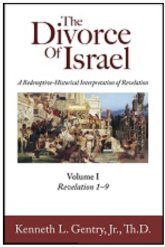 By Ken Gentry
By Ken Gentry
I have been asked by a number of people to see the Table of Contents of my Revelation commentary, which is due out April 15, 2024. So I will post this as an aside from my regularly scheduled blog articles.
The commentary can be pre-ordered at a discount:
https://www.kennethgentry.com/the-divorce-of-israel-2-vols-by-gentry-pre-publication-offer/
TABLE OF CONTENTS
Foreword by Martin Selbrede
Preface
1. Introduction
2. Superscription And Beatitude (1:1–3)
3. Greeting and Theme (1:4–8)
4. The Commissioning Vision (1:9–20)
5. Seven Oracles (2:1—3:22)
6. The Court Scene (4:1–11)
7. The Seven-Sealed Book (5:1–14)
8. The Seals Opened: The First Six Seals (6:1–17)
9. Two Interludes (7:1–17)
10. The Seals Opened: The Seventh Seal (8:1–5)
11. The Seven Trumpet Angels: The First Six Trumpets (8:6—9:21)
12. Third Interlude: The Little Book and John’s Action (10:1–11)
13. Fourth Interlude: The Measured Temple and Two Witnesses (11:1–13)
14. The Seven Trumpet Angels: The Seventh Trumpet (11:14–19)
15. The Sun-Clothed Woman And the Red Dragon (12:1–17)
16. The Beast From the Sea (13:1–10)
17. The Beast From the Land (13:11–18)
18. Visions of Blessing and Judgment (14:1–20)
19. The Seven Last Plagues (15:1—16:21)
20. The Harlot of Babylon and the Beast (17:1–18)
21. The Fall of Babylon the Harlot (18:1—19:5)
22. The Final Victory of the Lamb (19:6–21)
23. Satan’s Ruin and Final Judgment (20:1–15)
24. The New Creation’s Coming (21:1–8)
25. The New Jerusalem Bride (21:9–27
26. New Heaven and New Earth (22:9–17)
27. Final Testimonies and Admonition (22:6–15)
28. The Final Attestation and Blessing (22:16–21)
The Divorce of Israel: A Redemptive-Historical Interpretation of Revelation
This long-awaited commentary is now at the printer and should be available for the public in late April, 2024. It is an 1800 page, two-volume deeply exegetical, academic commentary on the Bible’s most mysterious book.
Pre-order today for a special discount. Click: https://www.kennethgentry.com/the-divorce-of-israel-2-vols-by-gentry-pre-publication-offer/
CREEDS IN SCRIPTURE?
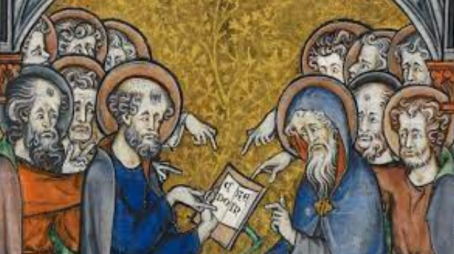 PMW 2024-025 Kenneth L. Gentry, Jr., Th.D.
PMW 2024-025 Kenneth L. Gentry, Jr., Th.D.
Creeds are important instruments for the securing and promotion of the Christian faith. The concept of creeds arise in Scripture itself. Certainly no law in Scripture explicitly commands “Thou shalt frame creeds.” Nevertheless, the impetus and mandate for creeds derives from good and necessary inferences deduced from Scripture.
We can demonstrate this in a variety of ways, three of which will suffice for our present purpose.
First, the biblical call for a public affirmation of faith serves as the prime impetus to creedalism.
The essence of Christian duty is to be a witness (Acts 1:8). This requires publicly defining the exact identity of that to which the Christian is witness. Obviously reciting the entire Scripture record at a given opportunity of witness is not possible. Furthermore, only God can look into the hearts of individuals to ascertain their innermost faith (1 Sam. 16:7; Luke 16:15). Thus, for others to know of an individual’s personal faith it is necessary to put it into words. “With the heart man believes, resulting in righteousness, and with the mouth he confesses, resulting in salvation” (Rom. 10:10). Hence, the necessity of a creed in defining the content of belief.
Nourishment from the Word
(by Ken Gentry)
Reformed studies covering baptism, creation, creeds, tongues, God’s law, apologetics, and Revelation
See more study materials at: www.KennethGentry.com
Second, mini-creeds are preserved in the biblical record of apostolic Christianity itself.
The very seeds of a full-blown creedalism are sown in the apostolic era via terse statements of faith which are widely employed. Perhaps the most familiar of these rudimentary creeds is the recurring one embedded in such texts as Acts 10:36; Romans 10:9; 1 Corinthians 12:3; and Philippians 2:11: “Jesus is Lord.” This eminently important statement embodies — “encreeds,” if you will — a particular way of viewing Jesus Christ. It is fundamentally necessary to hold as one’s credo: “I believe Jesus is Lord.”
Third, within the biblical record we find early ecclesiastical assemblies re-casting already known truths to ensure their accurate preservation and transmission.
Acts 15 is the locus classicus in this regard. There the Church restates “justification by faith” in response to a Christian-Pharisaic pressure demanding the circumcision of Gentile converts (cf. Acts 15:1).
[image error]For more information and to order click here.
" data-image-caption="" data-medium-file="https://postmillennialismtoday.files...." data-large-file="https://postmillennialismtoday.files...." class="alignright size-full wp-image-254" src="https://postmillennialismtoday.files...." alt="When Shall These Things Be? A Reformed Response to Hyperpreterism" />When Shall These Things Be?
(ed. by Keith Mathison)
A Reformed response to the aberrant HyperPreterist theolgy.
Gentry’s chapter critiques HyperPreterism from an historical and creedal perspective.
See more study materials at: www.KennethGentry.com
After noting several such situations in Scripture, nineteenth-century Scottish Presbyterian theologian James Bannerman observes: “Such, within the age of inspiration itself, are the remarkable examples we have of the necessity, growing out of the circumstances of the Church and its members, that arose at different times for recasting the doctrines of Scripture in a new mold, and exhibiting or explaining it afresh under forms of language and expression more precisely fitted to meet and counteract the error of the times.”
Thus the concept of creedalism is a Scriptural one that in no way diminishes the authority of Scripture or implies its inadequacy.
The Divorce of Israel: A Redemptive-Historical Interpretation of Revelation
This long-awaited commentary is now at the printer and should be available for the public in late April, 2024. It is an 1800 page, two-volume deeply exegetical, academic commentary on the Bible’s most mysterious book.
Pre-order today for a special discount. Click: HERE
March 29, 2024
GENESIS 2 EXPOSITION (2)
 PMW 2024-025 by Kenneth L. Gentry, Jr.
PMW 2024-025 by Kenneth L. Gentry, Jr.
This article concludes the two-part survey of Genesis begun in the last article.
Gen. 2:16
God commanded the man
This crucial command is given directly to Adam. Eve has not yet been created (2:22). This implies man’s functional loving and protective headship (not his superiority or dominance) over his wife within the family..
Gen. 2:17
you will surely die
Adam was not created in a declining and dying condition. But he was created capable of dying — if he disobeyed God. The covenant of works has consequences; man has responsibility. Death has two components, spiritual (Eph. 2:1; Col. 2:13) and physical. On the day Adam sinned, he died spiritually, but his body would eventually return to the dust physically (Gen. 3:19b; cp. Psa. 90:3; 104:29; Eccl. 12:7). This is certain because the Hebrew phrase behind “surely die” is a pleonasm, which is a dramatic verbal form expressing certainty. It may be literally translated “to die you will die.”
Gen. 2:18a
It is not good for the man to be alone
God created man in his image as male and female (1:27). Since God exists in a relationship as a Trinity (Father, Son, Holy Spirit), so must man as his image. That it is temporarily “not good” for Adam to be alone underscores the importance of companionship. A wife in Scripture is deemed “a good thing” from the Lord (Prov. 18:22; cp. Prov. 12:4; 19:14). At this juncture in creation week, however, this is the only aspect of creation declared “not good.” But this state of being “not good” was only temporary. At the end of creation week “God saw all that He had made, and behold, it was very good” (1:31). God created man first with the intention of creating woman for him (v. 22; cp. 1 Cor. 11:8; 1 Tim. 2:13), otherwise he could not procreate and fill the earth per God’s design and original command (1:28).
Nourishment from the Word
(by Ken Gentry)
Reformed studies covering baptism, creation, creeds, tongues, God’s law, apologetics, and Revelation
See more study materials at: www.KennethGentry.com
Gen. 2:18b
a helper suitable for him
Man is created first and separately from the woman, but he cannot accomplish his global task (1:26) alone, for it requires multiplying (1:28). The woman would be “suitable” for him, i.e., suited for him by corresponding exactly to him as his closest companion. Unlike his relation to the animals, she would be his physical, emotional, spiritual, and intellectual equal who also was in God’s image (1:27; 4:1–2; 5:3–4). Her being his “helper” does not imply her inferiority, for God is Israel’s “helper” (Deut. 33:7, 26, 29; Psa. 33:20; 30:10; 54:4).
Gen. 2:19a
out of the ground the Lord God formed
Here God’s forming the animals from the ground, and bringing them before Adam, does not contradict the chronology of 1:24, 26, where the animals are created before man. The verb “formed” has a pluperfect connotation, meaning “God already having formed….”
Gen. 2:19b
brought them to the man
In dealing with Adam’s temporary incompleteness (in that God is not yet finished creating the original couple from which mankind will arise), God brings the animals before him. Immediately before and after this animal review, the text states the intention of creating “a helper suitable” to Adam (1:18, 20). God was not using trial-and-error in a search for a suitable helper. Rather he is engendering in Adam a desire for a helper who would correspond to him on the human level. This is necessary not only for personal companionship but so that Adam might “be fruitful and multiply, and fill the earth” (1:28).
Gen. 2:19c
every beast of the field
Adam’s offspring will eventually name all the creatures of the entire world as an act of mankind’s divine call to dominion. But he starts the process of subduing the whole earth (1:28) by beginning on a small scale in a garden (2:8, 15). God’s supernatural assistance is certainly at work in bringing the animals to unfallen Adam. But his surveying and naming these animals may not involve the entire world. Like his beginning world dominion in Eden, this report may keep its focus on his immediate area, Eden. This may be why the text mentions “beast of the field” rather than the “beasts of the earth,” as in Genesis 1 (vv. 24, 25, 30). This may also explain why it refers only to those in his realm, not to the sea creatures (1:21–22). The birds “of the sky” are mentioned because they actually live “on the earth” (1:22) and would be in Eden.
Gen. 2:19d
that was its name
This is the first (and only) time we see Adam interacting with the animals. Thus, his first step in exercising dominion over them (as per Gen. 1:28; cp. Psa. 8:4–8) is to name them. In Scripture, to name something often implies authority or superiority over it. We certainly see this in God’s sovereign naming of portions of creation (1:5, 8, 10) and in various places elsewhere in Genesis (e.g., Gen. 2:19; 5:2; 17:5; 32:28). We also see this naming significance when God names the stars (Psa. 147:4; Isa. 43:1) and establishes Israel in the Promised Land (Deut. 12:5, 11). We see this also when someone conquers a city (2 Sam. 12:28), governs an area (Psa. 49:11), or leads a remnant of survivors (Isa. 4:1). This naming (or “calling”) would then be Adam’s creaturely reflection of God’s image.
Covenantal Theonomy
(by Ken Gentry)
A defense of theonomic ethics against a leading Reformed critic. Engages many of the leading objections to theonomy.
See more study materials at: www.KennethGentry.com
Gen. 2:20
the man gave names
In the Bible, names often define character, essence, or function (e.g., Gen. 2:23; 3:20; 17:5, 15; 25:26; 27:36; Matt. 1:23; Mark 3:16). Thus, Adam’s naming the animals was not solely to identify them (though it would include this as an exercises of his intellect). Rather it especially involves his exercise of authority over them by assigning them a function in his realm. And even more, contextually it shows that the animals could not function to be Adam’s “helper suitable for him” (v. 18): the animals could not assist him in reproducing (cp. 3:20; cp. 1:27–28).
Gen. 2:21
took one of his ribs
This literally signifies man’s rib, not simply his side (though the word can mean such): note that he has a plurality of them (“ribs”) from which only one is taken, then the gap is closed up.
Gen. 2:22a
taken from the man
Though everything in this section mentioned before the creation of woman was “from the earth” (2:7, 9, 19), the woman is “from the man” (cp. v. 23; 1 Cor. 11:8). She is the first creature in history to come from another living being.
Gen. 2:22b
brought her to the man
God not only ordained marriage as a creation ordinance but officiated at the first marriage by bringing the woman to the man. This entire episode underscores the divinely-ordained design for marriage: male and female (not homosexual). Jesus confirms both principles: “a man shall leave his father and mother and be joined to his wife, and the two shall become one flesh” (Matt. 19:5). God defines marriage, not man or the state, for Jesus speaks of marriage as being what “God has joined together” (Matt. 19:6b).
Gen. 2:23a
bone of my bones
Woman was literally “fashioned” (i.e., “built”) from man’s bone; she was not created fully formed in an instant by the command of God (as were the animals, 1:20, 24). Similarly Adam was “formed” from the dust. Both are carefully, lovingly created by God. The divine procedure in creating woman emphasizes the unity of husband and wife: at the beginning there was a literal physical unity (vv. 22–23) that is now emulated spiritually in marriage (Matt. 19:4–6; Eph. 5:28–29). True unity issues in harmony (Amos 3:3) and is especially expected in a believing context (Psa. 133:1; Matt. 18:19; Eph. 4:3; Phil. 2:2).
Gen. 2:23b
She shall be called Woman
Adam’s calling Eve “woman” emphasizes the God-designed and God-expected unity of man and woman: the Hebrew word ishshah indicates she came “from man [ish].” The fact that man “called” her “Woman” shows he authoritatively declared for all time that God created her from him. This should be recognized and understood in order to understand the true meaning of husband and wife relations. His recognizing her derivation from him entails neither the woman’s inferiority (the two are one, v. 24) nor the husband’s abusive power over her (Eph. 5:28–29).
Gen. 2:24a
leave his father and his mother
The word for “leave” (Heb., azab) is a vigorous word that can be translated “abandon, desert” (Eze. 23:29; 1 Kgs. 8:57). Here it strongly emphasizes that a new family unit is created in marriage, with a new authority structure. This does not entail any unloving abandonment of one’s parents, for elsewhere God’s law (Exo. 20:12) and Jesus encourage honoring them (Matt. 15:4–6).
Greatness of the Great Commission (by Ken Gentry)
An insightful analysis of the full implications of the great commission. Impacts postmillennialism as well as the whole Christian worldview.
See more study materials at: www.KennethGentry.com
Gen. 2:24b
be joined to his wife
The word “joined” (Heb. dabaq) speaks of clinging closely, so closely that the married couple may be said to “become one flesh.” Marriage is established by a solemn covenant (Prov. 2:17; Mal. 2:14) thereby serving as an image of God’s own loving commitment to his people (Jer. 31:31–32). We see the word translated “joined” (Heb., dabaq) used of covenant faithfulness in Deuternomy 10:20; 11:22; 13:4.
Gen. 2:25
not ashamed
Man and woman were originally naked but since sin was not yet in the world, thus they “were not ashamed.” Their shame arose before God, since they hide from him not from each other (3:8–11). This segues into the next narrative scene: (1) the word “naked” (Heb., arom) and “crafty” (arum, 3:1) are related; and (2) when they sin they recognize their nakedness as shameful. This narrative scene and the next explain the reason for and origin of clothing (3:21).
The Divorce of Israel: A Redemptive-Historical Interpretation of Revelation
This long-awaited commentary is now at the printer and should be available for the public in late April, 2024. It is an 1800 page, two-volume deeply exegetical, academic commentary on the Bible’s most mysterious book.
Pre-order today for a special discount. Click: HERE
March 26, 2024
GENESIS 2 EXPOSITION (1)
PMW 2024-024 by Kenneth L. Gentry, Jr.
 Once again I will offer a running overview of an important passage of Scripture. This two part series will present the creation of Adam, the planting of Eden, and the marriage of man.
Once again I will offer a running overview of an important passage of Scripture. This two part series will present the creation of Adam, the planting of Eden, and the marriage of man.
Gen. 2:7a
the LORD God formed
This shows the intensely personal creation of man. Animals were created en masse by a spoken word (1:20, 24); man was created as an individual by God’s carefully forming his body and in-breathing life into him (cp. 2:21–22). This is not a poetic, anthropomorphic image of a potter at work, for: (1) neither the word “potter” nor “hand” appear (as in Jer. 18:4, 6) and (2) potters do not work with “dust” but clay (Isa. 29:16; Jer. 18:4).
Gen. 2:7b
man
The Hebrew word for “man” is adam which is related to the word “ground” (adamah). As a land creature man is closely linked with the ground from the beginning (2:5, 9, 15–16; 3:16–19a; cp. 1:29). Under God’s curse for his rebellion, he will return to the ground (3:19b).
Gen. 2:8a
God planted a garden
God creates man in a perfect environment: a well-stocked garden (cf. v. 9). This will be man’s testing ground as a moral creature in God’s image (cf. vv. 16–17). God lovingly creates and cares for man, unlike the terrifying gods of Canaan (e.g., Lev. 18:21).
Gen. 2:8b
Eden
The uncertain word “Eden” may mean “luxurious pleasure,” signifying the wonderful setting. Here Eden speaks of the larger region in which the “garden” is planted: “God planted a garden toward the east, in Eden” (cp. v. 10a). In this perfect setting, God places two special trees in the very center of the garden for emphasis. Very little is said about them, with the tree of knowledge never mentioned again in the Bible after Genesis 3. We can, however, surmise a little from their names and the results of eating from them.

As It Is Written: The Genesis Account Literal or Literary?
Book by Ken Gentry
Presents the exegetical evidence for Six-day Creation and against the Framework Hypothesis. Strong presentation and rebuttal to the Framework Hypothesis, while demonstrating and defending the Six-day Creation interpretation.
See more study materials at: www.KennethGentry.com
Gen. 2:9a
the tree of life
Since Adam is already alive (v. 7), has many trees for food (v. 9; cp. 1:29), and is later forbidden access to the “tree of life” (3:24), this tree is not essential to sustaining life on a daily basis. Rather, it is related to gaining eternal life (Gen. 3:22; cp. Rev. 22:14). Apparently, God will grant free access to it after Adam passes a period of moral probation under this “covenant of works.” Unfallen man is under moral obligation to God after which he will earn access to the tree granting him eternal life. It is not a magical tree, which physically grants life, but a tree appointed by God to function like a sacrament or ordinance (such as baptism or the Lord’s Supper) signifying man’s confirmation for securing eternal life (cp. Rev. 2:7; 22:2).
This verse presents what theologians call the “covenant of works.” It is the covenant established by God with Adam before his fall into sin. In it God gives Adam a glorious garden and condition (2:8–9, 15, 18–24), but with a warning that disobedience will result in covenant cursing and death (vv. 16–17). The narrative in this section (beginning at 2:4) leads tragically to Adam’s disobedience and God’s curse (ch. 3). Adam broke God’s covenant (Hos. 6:7) and brought sin and death into the world (Rom. 5:12–19; 1 Cor. 15:22). The covenant of grace will replace this covenant when God reaches out to Adam in mercy and love offering him salvation by grace (cf. 3:15).
Gen. 2:9b
the tree of the knowledge of good and evil
This is the tree of moral testing within the covenant of works. Had Adam obeyed God’s command and avoided this tree (2:17), he would have eventually passed his probation and merited eternal life. He would thereby be granted access to the tree of life, which would confirm his eternal acceptance with God (3:22). This was not a magical tree that miraculously imparted knowledge. Rather it was a testing tree to see if man would let God be God, determining good and evil (by forbidding this tree as a test case). Instead, Adam himself sought to “be as God” autonomously determining right and wrong (3:5).
Gen. 2:10–14
four rivers
One river flowed through Eden then parted into four rivers. The garden was well-watered (vv. 6, 10–14; cp. 13:10), despite the lack of rain on the sixth day (v. 5). This passage does not report erroneous information simply because we do not see a common source to the Tigris and Euphrates today. We should understand that Noah’s later world-covering Flood (Gen. 7:19–20; Luke 17:26–27; 2 Pet. 3:5–6) must have radically altered earth’s topography. The Euphrates and Tigris are well-known rivers in the Bible (Gen. 15:18; Deut. 1:7; Dan. 10:4) and today. But apparently their names were re-used after the Flood in remembrance of this former estate.
When Noah disembarked the Ark he would surely have named places and rivers after earlier places he had known in the pre-Flood world. Why would he create all new names for everything? Similarly, today America has a river in New London, Connecticut, called the River Thames. This was obviously named after the famed river in England. Likewise, the River Trent in North Carolina was named after the river in England.
Geologists recognize that during the Indus period, the Sarasvati was a large river fed by the Sutledge and Yamuna rivers. But over time tectonic movements separated the Yamuna from the Indus system of rivers, eventually causing it to become smaller and fade away. The Amazon River once flowed, at least for a time, in the opposite direction than currently due to tectonic uplift.
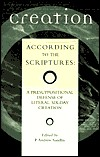 Creation according to the Scriptures
Creation according to the Scriptures
Ed. by P. Andrew Sandlin
This book is sub-titled: A Presuppositional Defense of Literal , Six-day Creation. It has chapters by R. J. Rushdoony, Andrew Sandlin, Kenneth Gentry, Cornelius Van Til, and others. It touches on historical, exegetical, theological, and philosophical implications of Six-day Creation.
See more study materials at: www.KennethGentry.com
Gen. 2:15
to cultivate it and keep it
God created man for fulfilling labor (1:26–28), not for lazy idleness. Work is a creation ordinance and is highly esteemed in the biblical worldview (Prov. 6:6–9; 19:15; 2 Thess. 3:10), being rooted in the very origin, meaning, and purpose of man here. Adam was called to subdue the whole earth, but he begins this in a small area, the garden in Eden. This is the first appearance of the principle of gradualism in Scripture (cp. Deut. 7:22; Isa. 28:10, 13). An ongoing principle of Scripture is here assumed: man is not to expect instant gratification.
To be continued….
Kenneth L. Gentry Jr.'s Blog
- Kenneth L. Gentry Jr.'s profile
- 85 followers



